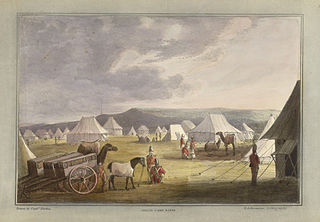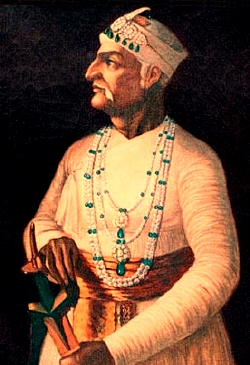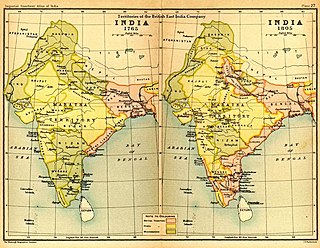
Hyderabad State was an independent monarchy/princely state located in the south-central Deccan region of Indian Subcontinent with its capital at the city of Hyderabad. It is now divided into the present-day state of Telangana, the Kalyana-Karnataka region of Karnataka, and the Marathwada region of Maharashtra in India.

The Maratha Empire, also referred to as the Maratha Confederacy, was an early modern Indian empire and later a confederation that controlled large portions of the Indian Subcontinent in the 18th century. Maratha rule formally began in 1674 with the coronation of Shivaji of the Bhonsle dynasty as the Chhatrapati. Although Shivaji came from the Maratha caste, the Maratha empire also included warriors, administrators, and other nobles from the Maratha and several other castes from what is known today as Maharashtra. The Maratha Kingdom was expanded into a full-fledged Empire in the 18th Century under the leadership of Peshwa Bajirao I.

Mir Qamar-ud-din Khan Siddiqi also known as Chin Qilich Qamaruddin Khan, Nizam-ul-Mulk, Asaf Jah and Nizam I, was the first Nizam of Hyderabad. He was married to the daughter of a Syed nobleman of Gulbarga. He began his career as a favourite of the Mughal emperor Aurangzeb, who made him a general. Following the death of Aurangzeb in 1707, Asaf Jah refused to favour any one of Aurangzeb's warring sons and as such remained neutral. When Aurangzeb's third son Bahadur Shah ultimately emerged victorious, Asaf Jah was rotated as governor of multiple Mughal provinces until 1714, when he was created Viceroy of the Deccan with authority over six Mughal provinces in southern India from 1714 to 1719. From 1719 onwards he was involved in combating the intrigues of the Sayyid Brothers. From 1720 to 1722 he helped the new Mughal emperor Muhammad Shah eliminate the Sayyed brothers and was rewarded by being elevated to the grand viziership from 1722 to 1724.

The Third Anglo-Maratha War (1817–1819) was the final and decisive conflict between the British East India Company and the Maratha Empire in India. The war left the Company in control of most of India. It began with an invasion of Maratha territory by British East India Company troops, and although the British were outnumbered, the Maratha army was decimated. The troops were led by Governor General Hastings, supported by a force under General Thomas Hislop. Operations began against the Pindaris, a band of Muslim mercenaries and Marathas from central India.

Nizam of Hyderabad was the title of the ruler of Hyderabad State. Nizam is a shortened form of Niẓām ul-Mulk, which means Administrator of the Realm, and was the title bestowed upon Asaf Jah I when he was appointed Viceroy of the Deccan by the Mughal Emperor Farrukhsiyar. In addition to being the Mughal Viceroy (Naib) of the Deccan, Asaf Jah I was also the premier courtier of the Mughal Empire until 1724, when he established the independent monarchy of Hyderabad and adopted the title "Nizam of Hyderabad".

Balaji Baji Rao, often referred to as Nana Saheb I, was the 8th Peshwa of the Maratha Confederacy. He was appointed as Peshwa in 1740 upon the death of his father, the Peshwa Bajirao I.

Madhavrao I was the son of Peshwa Balaji Bajirao and grandson of Peshwa Bajirao I who served as 9th Peshwa of the Maratha Confederacy. During his tenure, the Maratha Confederacy recovered from the losses they suffered during the Third Battle of Panipat, an event known as Maratha Resurrection.

Narayanrao was the 10th Peshwa of the Maratha Confederacy from November 1772 until his assassination in August 1773. He married Gangabai Sathe who later gave birth to Sawai Madhavrao.

Raghunathrao Bhat, also known as Ragho Ballal or Raghoba Dada, was the younger son of Peshwa Bajirao I who served as the 11th Peshwa of the Maratha Empire for a brief period from 1773 to 1774. He succeeded his Nephew Narayanrao.

Mirza Nizam Ali Khan Siddiqi, Asaf Jah II was the 5th Nizam of Hyderabad State in South India between 1762 and 1803. He was born on 7 March 1734 as fourth son to Asaf Jah I and Umda Begum. His official name is Asaf Jah II, Nizam ul-Mulk, Nizam ud-Daula, Nawab Mir Nizam 'Ali Khan Siddiqi, Fateh Jang, Sipah Salar, Nawab Subedar of the Deccan. Sawānih-i-Deccan, a Persian work compiled by Munim Khan, a military commander during the era of Asaf Jah II gave more insight about administration of Asaf Jahis.

Mahadaji Shinde, later known as Mahadji Scindia or Madhava Rao Scindia, was a Maratha statesman and general who served as the Raja of Gwalior from 1768 to 1794. He was the fifth and the youngest son of Ranoji Rao Scindia, the founder of the Scindia dynasty. He is reputed for having restored the Maratha rule over North India and for modernizing his army.

The Maratha Conquests were a series of conquests in the Indian subcontinent which led to the building of the Maratha Empire.

The Carnatic Sultanate was a kingdom in South India between about 1690 and 1855, and was under the legal purview of the Nizam of Hyderabad, until their demise. They initially had their capital at Arcot in the present-day Indian state of Tamil Nadu. Their rule is an important period in the history of the Carnatic and Coromandel Coast regions, in which the Mughal Empire gave way to the rising influence of the Maratha Empire, and later the emergence of the British Raj.

Madhavrao II was the 12th Peshwa of the Maratha Empire in India, from his infancy. He was known as Sawai Madhav Rao or Madhav Rao Narayan. He was the posthumous son of Narayanrao Peshwa, murdered in 1773 on the orders of Raghunathrao. Madhavrao II was considered the legal heir, and was installed as Peshwa by the Treaty of Salbai in 1782 after First Anglo-Maratha War.
Gopikabai was Peshwin of Maratha Empire, as the wife of Peshwa Balaji Baji Rao. She had a very orthodox religious upbringing and belief. After the death of Nanasaheb Peshwa, she tried to expand her power over the Peshwa and the administration. She influenced her son Madhavrao Peshwa, who by sidelining Raghunathrao at her urging, assumed control. However, after trying to interfere in administrative matters, namely to save her brother from punishment, she was confined to Nashik. In 1773 she was freed after the death of Madhavarao and went back to Pune. Afterwards, Gopikabai became part of the priestly class. She developed a rivalry with other women in the Peshwa's household. She was the mother of three successive Peshwas.

The Siege of Trichinopoly was part of an extended series of conflicts between the Nizam of Hyderabad and the Maratha Empire for control of the Carnatic region. On 29 August 1743, after a six-month siege, Murari Rao surrendered, giving Nizam ul Mulk (Nizam) the suzerainty of Trichinopoly. By the end of 1743, the Nizam had regained full control of Deccan. This stopped the Maratha interference in the region and ended their hegemony over the Carnatic. The Nizam resolved the internal conflicts among the regional hereditary nobles (Nawabs) for the seat of governor (Subedar) of Arcot State, and monitored the activities of the British East India company and French East India Company by limiting their access to ports and trading.
The Bhat Peshwa family earlier known as Bhat family is a prominent Indian Chitpavan Brahmin family who dominated India for around 100 years in the late 18th century and early 19th century. Most of the members in this family were the Peshwas in the Peshwa Era of the Maratha Empire, and Peshwa later became their family name. During their regime, most of the Indian subcontinent was under their control. The last Peshwa, Baji Rao II, was defeated by the British East India Company in the Third Anglo-Maratha War in 1818. The territory was annexed to the British East India Company's Bombay Presidency, and he was pensioned.

The Assassination of Narayan Rao occurred on 30 August 1773, when the 18 year old Peshwa of the Maratha Confederacy Narayan Rao, was assassinated. This plot was carried out During the Ganesh Chaturthi Festival that took place from 21 to 31 August. This was plotted by his uncle Raghunath Rao and his wife Anandibai. They used members of the Kalbelia tribe as assassins. Raghunath Rao was the next in line for the throne, at the time of Narayan Rao's death. Narayan Rao and his servant Chapaji Tilekar were both killed. A total of eleven people had been killed in the palace, seven of them were Brahmins, two servants, two maids. One cow was also killed.
The Marathas, under the leadership of Peshwa Madhavrao and his uncle Raghunathrao, defended a campaign of the Nizam's forces and eventually defeated them in the Battle of Uruli. This victory helped the Marathas regain their control over the Deccan region and weakened the power and influence of the Nizam.

The Maratha-Nizam wars (1720–1819) was a series of military conflicts between the Maratha Empire and the Nizam of Hyderabad, spanning nearly a century. These conflicts arose primarily from the Marathas' imposition of Chauth, a form of tribute, on the Nizam's dominions, leading to tensions and subsequent hostilities between the two powers. The Nizam's response to the Maratha demands sparked a series of clashes and wars aimed at resisting Maratha encroachment and asserting territorial sovereignty.















